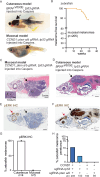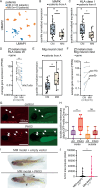Specific oncogene activation of the cell of origin in mucosal melanoma
- PMID: 40695831
- PMCID: PMC12284105
- DOI: 10.1038/s41467-025-61937-1
Specific oncogene activation of the cell of origin in mucosal melanoma
Abstract
Mucosal melanoma (MM) is a deadly cancer derived from mucosal melanocytes. To test the consequences of MM genetics, we develop a zebrafish model in which all melanocytes experience CCND1 expression and loss of PTEN and TP53. Surprisingly, melanoma only develops from melanocytes lining internal organs, analogous to the location of patient MM. We find that zebrafish MMs have a unique chromatin landscape from cutaneous melanomas. Internal melanocytes are labeled using a MM-specific transcriptional enhancer. Normal zebrafish internal melanocytes share a gene expression signature with MMs. Patient and zebrafish MMs show increased migratory neural crest and decreased antigen presentation gene expression, consistent with the increased metastatic behavior and decreased immunotherapy sensitivity of MM. Our work suggests that the cell state of the originating melanocyte influences the behavior of derived melanomas. Our animal model phenotypically and transcriptionally mimics patient tumors, allowing this model to be used for MM therapeutic discovery. As this is a non-MAPK driven genetically engineered model of melanoma, our work also has implications for the 15% of cutaneous melanoma patients who lack MAPK-driving mutations.
© 2025. The Author(s).
Conflict of interest statement
Competing interests: L.I.Z. is a founder and stockholder of Fate Therapeutics, CAMP4 Therapeutics, and Scholar Rock. He is a consultant for Celularity. B.J.A. is a shareholder in Syros Pharmaceuticals. E.I.B. serves as a consultant/advisory board member for Obsidian, Zola, Anaveon, Merck and Werewolf pharmaceuticals. G.M.B. has sponsored research agreements through her institution with: Olink Proteomics, Teiko Bio, InterVenn Biosciences, Palleon Pharmaceuticals, Astellas, and AstraZeneca. She served on advisory boards for: Iovance, Merck, Moderna, Nektar Therapeutics, Novartis, Replimune, and Ankyra Therapeutics. She consults for: Merck, InterVenn Biosciences, Iovance, and Ankyra Therapeutics. She holds equity in Ankyra Therapeutics. The remaining authors declare no competing interests.
Figures




Update of
-
Specific oncogene activation of the cell of origin in mucosal melanoma.bioRxiv [Preprint]. 2024 Apr 26:2024.04.22.590595. doi: 10.1101/2024.04.22.590595. bioRxiv. 2024. Update in: Nat Commun. 2025 Jul 22;16(1):6750. doi: 10.1038/s41467-025-61937-1. PMID: 38712250 Free PMC article. Updated. Preprint.
References
MeSH terms
Substances
LinkOut - more resources
Full Text Sources
Medical
Molecular Biology Databases
Research Materials
Miscellaneous

